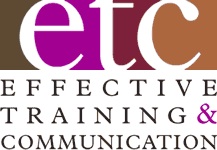Audience-Centric presenters harness the Physical Power of their bodies by standing and delivering with credibility and confidence. Because your audience only knows what it sees, your body can be a great natural visual aid. It can also show nervousness or lack of confidence very quickly and clearly. So … look the part you’re playing – a confident and credible presenter.
Stand Clear
If you’re delivering a presentation without PowerPoint slides, your ‘spot’ is in the center of the front of the room. Be equidistant from both sides of the audience and face the center of the group. This way, you can connect with everyone with focused and sustained eye contact.
If there’s a podium in the room, try to avoid it at all costs. A podium is a presenter’s worst enemy. Standing behind it creates a physical barrier between you and the audience and you look like you’re hiding from them. The podium also blocks much of the physical energy and confidence your body can project.
If you’re in a big room and the podium has a hard-wired mic that you must use, try standing next to it closer to the center and repositioning the mic accordingly. You can still leave your notes on the podium and glance at them – in silence – as needed.
If you’re using slides, position yourself to the audience’s left of the screen where possible. People read left to right and you want them looking at you unless you direct their attention to the screen. It’s also easier for you to glance at the screen – in silence – if you’re using it as a prompter. Just be sure you don’t block anyone’s view of the screen, especially from the sides. And don’t walk in front of it. Your shadow on it is distracting and annoying. And if you’ve ever looked directly into the projector, you know how painful that can be.
Stand Straight
A confident presenter stands straight, but looks natural and comfortable. Plant your feet about shoulder width apart with your knees slightly bent and your weight balanced evenly on both feet. You can stand this way for a long time without seeming unnatural or being uncomfortable.
Avoid the typical tendencies to sway back and forth, rock from side to side or shift your weight from foot to foot. These unmotivated movements don’t accomplish anything positive, but they do tell your audience that you have too much nervous energy. This doesn’t mean that your body is rigid – not at all. You can move your head, arms and torso as needed. Just try to keep your feet firmly planted and your weight balanced.
Stand Still
Stand still unless you have a good reason to move – easy to say, but hard to do. Aimless pacing around doesn’t accomplish much, unless you think a moving target is harder to hit. So, what are good reasons to move?
1. Move to the laptop to change slides. But do so silently, then move back to your spot.
2. Move closer to the screen to highlight something on it. But avoid using a laser pointer. If the slide is that complicated that you can’t direct the audience to a particular part, consider better slides.
3. Move closer to someone who asks a question or that you want to engage. But, return quickly to your spot. Otherwise part of the audience gets to look at your backside.
4. Move to a front table if that’s where you keep your notes, then move back. And … you get the picture by now – do so silently.
5. If the audience is at tables and you want to work the whole room to keep everyone engaged, that’s fine. But, when you move to the back of the room, you force many audience members to turn around to look at you. At your backside, actually. That’s a motivated movement, but keep it to a minimum.
So, project more credibility and confidence by harnessing the Physical Power of your body. It takes some practice and planning, but it’s worth the effort. Stand and deliver – stand clear, stand straight and stand still.

